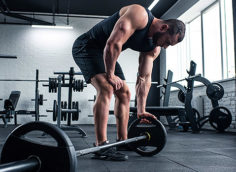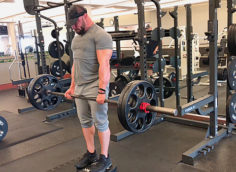Hack squats are named after Russian strongman and wrestler George Hackenschmidt and are traditionally done with a barbell. This old-school bodybuilding favorite is a good quad builder.

However, the Smith machine is superior to the barbell. I realize this is training blasphemy, but hear me out.
With the barbell, balance is a major issue. The Smith machine gives you some leeway and allows you to really focus on nailing your quads. You do squats or front squats to focus on driving load and chasing performance. Smith machine hack squats are a nice addition to the big basics. You can concentrate solely on quad stimulation and hit failure safely.
The reverse band has two roles. First, it allows you to match the exercise's resistance profile to your strength curve. Accommodating resistance is a powerful tool in this regard.
Secondly, the reverse band de-emphasizes the lowering portion of the lift. A conventional band set-up pulls you down and makes you work harder on the lowering phase. Not necessarily a bad thing, but for the application of this lift I prefer the reverse band. It allows you to really slow the lowering phase and focus on the quads doing the work.
With the bands attached from the bottom, people tend to "dive-bomb" down and explode up using momentum rather than the quads. That reduces the time under tension and also makes form breakdown more common. The torso shifts forwards and the tension shifts to the hamstrings, glutes, and spinal erectors. Not what we want out of our targeted quad-builder.
Having your heels elevated allows you to stay more upright. That upright torso places more emphasis on your quads and minimizes the contribution of the posterior chain. This is good for quad growth.
The elevated heels achieve this via two mechanisms. First, they reduce the amount of dorsiflexion required to sit deeply into the lift. Many lifters lack ankle mobility, so this set-up helps a ton.
Second, the heel lift artificially lengthens your shin. As a consequence, the ratio between thigh and shin length is changed. This alteration means your hips can sit ever so slightly further back while you stay upright. As a result, your center of mass shifts slightly and creates a longer lever arm through the femur. All of this creates a bias of workload on your quads. Exactly what we want.
When doing the exercise, control the lowering phase on a 5 count. Let the knees travel as far forward as possible. Squeeze up. Don't bounce or use momentum. Contract your quads to initiate the movement and maintain a vertical torso angle throughout.
Stop 95% of the way up, just shy of lockout to keep tension on the quads, before doing the next rep.





